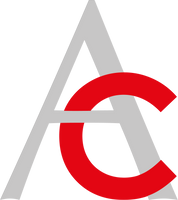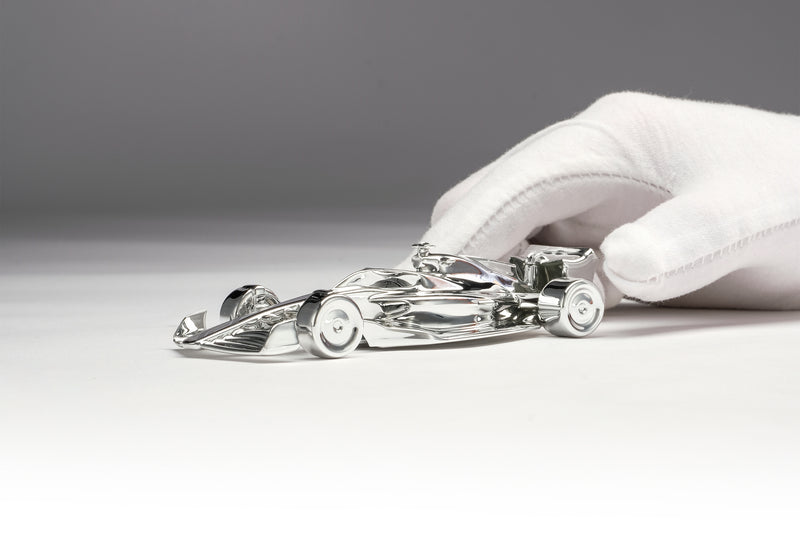Formula 1® Concept 2022 Sculpture
THE F1 CONCEPT 2022 SCULPTURE
With a complete reworking of the F1 regulations coming in 2022, the cars will look radically different. The F1 Concept 2022 design that Formula 1 Group has shared with Amalgam, is a compelling taste of what the cars will look like under the new regulations. Amalgam's beautiful miniature sculpture by Remco de Reus captures the essence of the F1 Concept 2022 design, and distils it into a fine collectable piece.
Amongst luxury and classic car owners and model collectors, Amalgam Collection are renowned and respected as makers of the world’s finest large scale car models for Ferrari and the cream of the high-end European car brands and F1 Teams. Now we have entered new territory with the creation of beautifully worked miniature car sculptures designed by artist Remco de Reus. We will create a growing number of miniature sculpture collections, that capture the essence of the most extreme and outstanding designs from the 1920s through to the present day. A collection is planned that spans the decades of F1 since 1947 through to the present day, capturing the essence of the most significant cars throughout F1 history.
Each sculpture is hand cast, hand finished, primed, plated in aluminium and finally clear lacquered and polished. The sculpture comes with a booklet containing details of the rule changes and their impact on the car design, all enclosed in a beautiful presentation box.
NEWLY DESIGNED CARS FOR 2022
The 2022 cars will have a radical new design philosophy and striking new look, with sweeping bodywork, simplified front wings, bigger rear wings, increased underbody aerodynamics, wheel wake control devices, simplified suspension, and low-profile tyres with 18-inch rims.
IN MORE DETAIL: THE 2022 CAR - IMPORTANT CHANGES
Formula 1 2022 RULE CHANGES - 10 KEY POINTS
After plenty of discussions, the new rules for the 2020 Formula 1 World Championship have finally been unveiled, and a lot will change both on and off the track. Formula 1 hopes that the new formula will bring more exciting racing both in the immediate and in the distant future.
The biggest changes for 2022 are in the technical regulations where the cars will look very different. As part of a huge push to increase the number of exciting races, the aero formula has undergone considerable development but there are still plenty more changes under the skin.
1. THE RETURN OF GROUND EFFECT CARS
Ground effects have not been permitted in Formula 1 since 1982, but the calls for their reintroduction have become rather loud in recent years with Formula 1 looking to reduce the current reliance on wings for downforce, which have been blamed for the dirty air that makes close-quarters racing difficult. The idea of ground effects coming back has been a lot more attractive to F1 for all constructors. Now they have returned with the creation of a very pronounced entry at the front of the floor as the air moves through two venturi tunnels. As the air flows under the car it’s squeezed through the point closest to the ground developing an extreme low-pressure area and creating a large amount of suction underneath. This means the floor is relied on more for downforce and reduces the weight produced by various bodywork components. Unlike the old school ground effects the car won’t have any sliding skirts, and instead has a range of fins underneath to minimize any disturbance. To make sure each team uses the floor as it should, a standard tea tray will be developed to attach to the front of the floor.
2. BRAND NEW BODYWORK
There’s a lot of change to the amount of bodywork for the next breed of F1 cars in 2022. The massively complex barge boards will be completely removed, and in their place comes a new breed of wheel bodywork which intends to minimize the effects of the wake, created by the wheels as they rotate. Wheel covers return, and the front wheels now have a deflector over the top to assist with that wake management. The front wing has also been redefined, and can now be made up of a maximum of four elements overall. Most crucially the end plates now look very different and are produced with a smooth blend from the front wing elements to a single-piece end plate upturned like an airplane’s wing. The nose also attaches directly to the wing much as it used to before the mid - 1990s. The rear wing has also been redesigned and can almost be described as M plate - less. Instead it loops around into a beam wing mounting, aiming to slash the strength of the vortices produced at the rear of the car, which is currently blamed for cars being unable to follow each other. For the time being DRS remains. Product numbers look good so far, and the F1 and the FIA have noticed that when one car follows behind another competitor, the following car now has around 86% of its usual downforce compared to the 55% it currently experiences. If that translates to the circuit it will be very good for close racing.
3. ENGINE REGULATIONS GET MINOR TWEAKS
The current turbo hybrid formula wasn’t going to change much for 2021 and although there were discussions to remove the MGH, it was decided that it would remain on the car. But to reduce overall costs the power units are allowed to be a little bit heavier, and must now be made of commercially available materials, so no exotic or exclusive materials are allowed in their construction. Engine supply customers must now have the option of equally specified equipment including software and fuels. Teams can opt out of this if they have commercial agreements elsewhere, or other preferences in place, but manufacturers must at least offer up their engine maps and fuels.
4. NEW PARTS CLASSIFICATIONS
The new rules are prescriptive, so to produce the desired on track product, a revised set of parts classifications have been devised. ‘Listed parts’ are those a team must design itself, such as aero parts. ‘Standard Parts’ are those everybody must use, including pitstop equipment. ‘Transferable Parts’ are those that may be bought and sold between teams, such as gearboxes and clutch mechanisms. So Hass can continue to buy parts from Ferrari. There are two new classifications; ‘Prescribed Parts’ must be designed to the letter, these include wheel aerodynamics, hubs and the tea tray; ‘Open Source Parts’ can be designed by a group of teams, and can then be made available to all. That includes DRS mechanisms, brakes for the next two seasons, and steering wheels.
5. SPORTING REGULATION CHANGES
The changes to the sporting regs that involve the technical side, include the more tightly regulated CFD and wind tunnel running, now called ‘aero testing restrictions’ or ATR. These include a maximum of 400 restricted wind tunnel runs for 2022, dropping to 324 runs in the following years. This also furthers the CFD restrictions, meaning the teams have a lot less to work with in this area throughout each season. The dyno testing allowance of power units will also be reduced to minimize costs. There are also new penalties for brake pads and discs which are now restricted to one new set per round. First time offenders against the ruling get a three place grid penalty, and two places will be docked for each subsequent transgression.
6. THREE DAY WEEKENDS
With Formula 1 planning to increase the number of races in 2022, they have cut Thursdays from the current schedule to ease the burden . That means that scrutineering is moved to a Friday morning, and that’s going to change things quite a bit. Teams are only allowed to race with what is sent to scrutineering on Friday. Teams can still run development parts in practice, but they can’t then decide to race with those parts that weekend. It has to have gone through scrutineering first. So teams might have to take a gamble before the weekend on a new part, rather than wait and see if the data looks good.
7. NEW SAFETY FEATURES
The current problem of Formula 1 is the amount of on track debris which can often interrupt races or cause damage if it’s not disposed of swiftly. One of the key new safety features for 2022 is that select parts will be covered in a rubber membrane to stop them from shattering so easily. This means that on track debris should be reduced, while the intention is also to stop front wings from detaching from cars. Some of the components at the rear of the car will also be tethered to keep them attached in the event of an accident. The nose will be longer to improve the energy absorption, while the side impact structures will also be strengthened, and cockpits will be made larger to help taller drivers. Caveat of this is that weight will increase from the current 743 kilograms to 768.
8. COST CAP
From 2022 all Formula 1 teams will be subject to a $175 million dollar cost cap. Although there are a few exceptions such as marketing and driver salaries, the cost cap is mainly focused on the production, development and running of each car. Any breaches of the cost cap will be subject to a serious penalty, ranging from fines and reprimands in minor cases, to suspension or exclusion from the championship in the worst cases. This means that R&D costs will have to drop in order to meet the new cost cap, creating a knock-on effect on the technical rules.
9. GEARBOX AND SUSPENSION CHANGES
To help limit the R&D costs, gearboxes will be frozen from 2021 to the end of 2025. In that time period there can only be one upgrade to the gearbox specification. Suspension regulations now only permit springs and dampers, meaning that solely using torsion bars will no longer be allowed. The heave springs or ‘inerters’, as they’re also known, will also be banned to simplify the suspension systems. Suspension uprights must now be included within the wheel assembly, meaning no external mounting points are now permitted. Brake discs and pads will be made larger to accommodate the new 18-inch wheels, while tyre blankets will eventually be phased out, but not until 2023. Until then, these will become standardized.
10. RULES FOR THE CAD AGE
Each team will have to submit CAD designs for developments of its cars, and the FIA will monitor whether the design fits within the defined reference basis and reference volumes. During scrutineering the cars can be scanned and measured against the CAD files, meaning that any transgressions of the rules can be immediately detected, making it easy to determine whether a car is legal or not.
The F1 logo, FORMULA 1, F1, GRAND PRIX and related marks are trademarks of Formula One Licensing BV, a Formula 1 company. All rights reserved.
--------------------------------------------------------------
These sculptures form part of the growing Amalgam Sculpture collection.
Pre-order
Bespoke
In order for us to create your bespoke model, you will need to choose 4 extra options. Paint colour, interior colour, wheel style and caliper colour.
Please complete the form and a member of our Sales Team will contact you.
Contact Us
Please contact us for more information about ordering this model.


